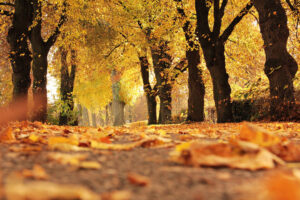Fall Allergies
When it comes to fall allergies, weeds and molds are the main triggers. Ragweed is the number one cause of fall hay fever symptoms in the United States, and flourishes here in the Midwest. Its pollen can travel as far as 400 miles, so you may be affected by ragweed even though it does not grow nearby. The good news is that ragweed season ends after the first frost.
There are also certain trees and grasses that pollinate in the fall, including many elm trees. In addition, outdoor molds become plentiful in the fall in gutters, soil, vegetation, rotting wood, and fallen leaves.

Sneezing and Wheezing?
Allergies are caused by particles in the air that we inhale. The body recognizes these particles as foreign and produces a histamine response – watery eyes, sneezing, runny nose. In the fall, when trees and plants and drying out and going to seed, there’s more particulate matter in the air.
The histamine response is why many people reach for over-the-counter “antihistamines” which block this reaction. However, antihistamines produce their own undesirable side-effects such as drowsiness and lack of mental clarity. Certain antihistamines can also have negative interactions with certain high blood pressure medications, so allergy sufferers would be wise to alert their pharmacist or doctor if they are taking medication for high blood pressure.
Some people use nasal sprays for allergies, which can irritate nasal linings.
There are several natural and herbal preparations that can help allergy sufferers, such as vitamin C and other antioxidants, herbal preparations specifically designed for allergies, and homeopathic remedies. Many people find acupuncture helpful in combating allergy symptoms. NUHS Whole Health Centers help patients try natural therapies first before relying on medications.
There are also simple strategies for reducing fall allergy symptoms. In the fall, many people are turning on their heaters for the first time.This fills the air with dust and other particulates which aggravate allergies. Take the time to clean or change your furnace filter, and run your furnace with the windows open the first time you turn it on.
Pollen and mold spores are stirred up when vacuuming, mowing, or raking leaves. If you are very sensitive, it is best to wear a face mask while doing these chores. Try to reduce outdoor activity on dry and windy days.
To reduce mold spores that may enter the home, it is best to remove leaves, clippings, and compost from around your house. Also be sure to repot plants outdoors. Trees and brush that overhang your house should be cut back. After spending extended periods of time outdoors be sure to shower and change clothes to remove built-up pollen from skin, hair and clothing.
You may notice your symptoms are worse at a certain time of day. Pollen counts are highest between 5 and 10 am, while mold spore counts peak in the afternoon.
Some people have chemical sensitivities which are different than allergies. Sensitivities are different because although an airborne substance can make you feel bad, there is no histamine reaction. Nevertheless, it is helpful to avoid car fumes, perfume and cigarette smoke, especially during allergy season, as this helps reduce the load on your body’s immune system.
The “load effect” of allergies on the immune system is one of the reasons people contract colds or respiratory illnesses in the fall. Many people think they get a cold in the fall because they’re outside in the windy and cooler weather. Actually allergies have taxed their immune system leaving them more vulnerable to such infections. Again, vitamin C is especially helpful, not only as a natural decongestant for allergy sufferers, but as a nutritional support for the immune system.
Those suffering from fall allergies wishing to explore natural therapy for relief can call the National University of Health Sciences Whole Health Centers.

